Vol 5 No. 20 TROPIC LIGHTNING NEWS May 25, 1970
Index
25th Secures Lifeline Road
By SP4 CHARLES SELF
THIEN NGON -- To reach Cambodia, 25th Infantry Division troops had to conquer
Route 22 - the only road from Tay Ninh to Thien Ngon in War Zone C, a queazy
thrity kilometers of uncertainty. They did!
It’s a slow, dusty, tossled ride where brush and trees close in too close and
where men have good cause to fear mines.
But Route 22 has to be traveled. It is the only ground route from the rear
support bases of Cu Chi and Tay Ninh to the division’s forward supply point east
of Cambodia.
War Zone C formerly was occupied by elements of the First Air Cavalry
Division - an air mobile unit with considerable air assets. Supplies could be
flown in for operations then.
But the 25th Infantry Division, with fewer air vehicles organic to it, must
depend upon support units for air resupply. The critical items can be carried
by Air Force C-130s and the very critical supplies can go by Chinook.
But most items must travel on road convoys and those convoys must go up Route
22.
“The complication is we only have one road. The enemy knows there is only
one road. Sweeping and security then become much more important,” said
Lieutenant Colonel Ralph Salucci, First Brigade Executive Officer.
“We have to secure our life-line in order to operate in our A.O. (area of
operations).”
“The road net in the area is practically non-existent,” he said. “Some
east-west routes exist,” he added, but only Route 22 runs north and south.
When the 25th Division moved into the area the division’s 65th Engineers
upgraded the narrow, winding dirt road, and swept the road clear of mines.
“You need infantry and armor to secure a road sweeping operation,” Salucci
pointed out. “It’s a laborious, difficult task to open the road. Once you open
the road you have to outpost-it so anything you want to move on the road can get
through without being ambushed.”
“We’re going to have the double problem of beating the road to death with
heavy traffic.”
Route 22 is open. Armored units of the 25th Infantry Division bounced up the
powdery surface early this week and established the unit’s control over the
area.
| ROLLIN’ ACROSS -- Mechanized elements of the 25th Division’s 1st Brigade roll across a pontoon bridge into Cambodia. The bridge, about 3 ½ miles east of Tasuos, was built by the 25th’s Echo Company, 65th Engineer Battalion. |
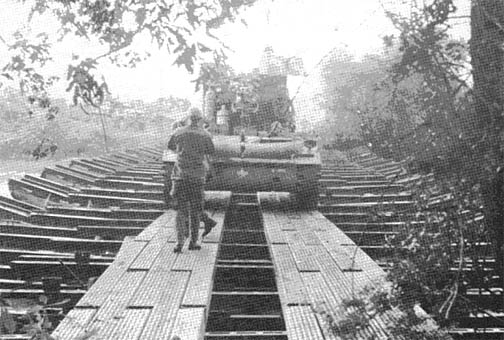 |
Regulars’ Drive Kills Nine
By SP4 BRIAN FLAHERTY
TASOUS, CAMBODIA - Soldiers of the 25th Infantry Division traded punches
Monday with Communist forces in Cambodia, killing nine NVA in the Division’s
first penetration into that country.
While Alfa, Bravo and Delta Companies from the Division’s 3rd Battalion, 22nd
Infantry, were air-lifted to Tasuos village four miles inside the Cambodia,
Charlie Company secured the western bank of a river crossing at the border.
The 3/22nd met little resistance while securing advanced positions.
The contact followed the unit’s insertion into a cold LZ. As they advanced
through Tasous, the enemy opened up with small arms fire. With the help of
gunships, the Tropic Lightning troops closed in, killing nine, then setup
security for the arrival of 1st Brigade mech units.
Specialist 4 Don James, of Joplin, Mo., said, “The operation didn’t seem any
different than previous ones.”
But Specialist 4 E.D. Rosa, of New York City, said, “The psychological effect
of operating in Cambodia made me a bit nervous at first, but once we settled
down, the operation smoothed out.”
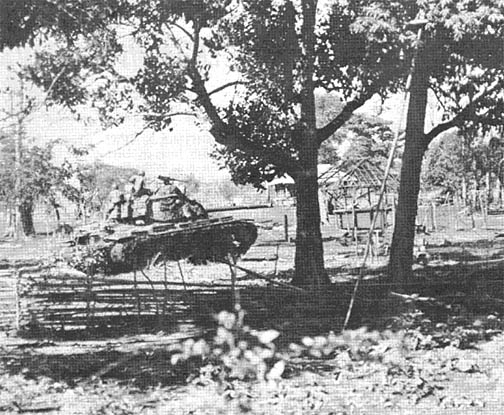 |
DREADNAUGHT ACTION -- A “Dreadnaught” M48 tank of the 25th Division’s 2nd Battalion, 34th Armor, assaults an NVA village in the Fishhook region of Cambodia. |
Wolfhound’s Scout Turns Twice on NVA
By SP4 GREG STANMAR
CU CHI - Communist soldiers recently captured Huynh Van Vu, a 25th Infantry
Division Kit Carson Scout - by now, they are probably sorry they did.
Van Vu was scouting for the division’s 2nd Battalion, 27th Infantry, on a
sweep within 50 yards of the Cambodian border. Because of the sensitivity of
the location, his company remained several hundred yards behind while he
thoroughly reconned the area.
“I walk with rifle on safety and come into six NVA,” said the Scout. “I can
do nothing.”
He was subdued and taken across the border. Once there, he underwent several
weeks of indoctrination and harassment with at least seven other Hoi Chanhs who
had also been captured.
When word was received that Cambodian troops were going to sweep the area,
Van Vu was quickly given his mission and sent back into the Republic of
Vietnam. His hands were tied behind his back and he was to act as an escaped
prisoner rallying to the government. Once reinstated as a Kit Carson, he was to
become a spy for the enemy.
Van Vu followed his orders to the letter - until he was found by the 25th
Division’s C Company, 2nd Battalion, 14th Infantry.
“We found him with his hands tied up, but otherwise quite alright,” said
Captain William Branch, of Barnesville, Ga. “He was pretty tired though,- and I
don’t blame him.”
Van Vu immediately told the division’s intelligence people everything he had
learned while in Cambodia.
“Besides the information Van Vu gave about the large unit operating inside
Cambodia, he supplied us with a new angle on the Communists’ strategy,”
commented Branch.
Page 2 TROPIC LIGHTNING NEWS May 25, 1970
Decorated
| SILVER STAR | |
| CPT Gerald M. Bonti, Co A, 1st Bn, 5th Inf CPT Michael J. Neuman, Co C, 2d Bn, 12th Inf |
SSG Patrick S. Cardona, Co A, 1st Bn, 5th Inf |
|
DISTINGUISHED FLYING CROSS |
|
| LTC Shepperd H. Phillips, HHC, 2d Bn, 12th Inf MAJ Richard W. Cato, HHC, 2d Bn, 12th Inf |
MAJ William B. Mason, HHS Btry, 3d Bn, 13th Fld Arty 1LT Fred M. Perryman, HHB, Div Arty |
|
SOLDIER'S MEDAL |
|
| SSG Freddie E. Wood, A Trp, 3d Sqdn, 4th Cav | |
| BRONZE STAR |
|
|
CPT Chrisman Bonnell, HHC, 3d Bde WOl Lewis D. Braswell, HHC, 3d Bde WOl Griffin E. Fisk, HHC, 3d Bde WOl Howard R. Lusk, HHC, 3d Bde WOl Craig T. Tate, HHC, 3d Bde SFC John J. Hynes, HHS Btry, 1st Bn, 8th Fld Arty SSG Frederick J. Boshaw, Co B, 2d Bn, 27th Inf SSG Charles T. Farmer, Co B, 2d Bn, 27th Inf SSG Paul K. Sanford, Co B, 2d Bn, 27th Inf SGT Thomas L. Brown, Co A, 1st Bn, 5th Inf SGT Larry M. Gassner, Co B, 2d Bn, 27th Inf SGT Stephen S. Moore, Co B, 2d Bn, 27th Inf SGT Daniel G. Pollock, Co B, 2d Bn, 27th Inf SGT Eugene Poole, Co C, 2d Bn, 12th Inf SGT Solon Ralston, Co B, 2d Bn, 27th Inf SGT Jimmie C. Rucker, Co B, 2d Bn, 27th Inf SGT David Quinones, HHC, 1st Bde SGT Earl D. Smith, Co B, 2d Bn, 27th Inf SGT Kenneth S. Vore, Co A, 1st Bn, 5th Inf SP4 Walter T. Amick, Co B, 2d Bn, 27th Inf SP4 James Baresich, Co B, 2d Bn, 27th Inf SP4 Dennis L. Burns, HHC, 2d Bn, 27th Inf SP4 Carl J. Caprood, Co B, 2d Bn, 27th Inf SP4 Roy T. Cordova, Co A, 1st Bn, 5th Inf SP4 Daniel R. Diaz, Co B, 2d Bn, 27th Inf SP4 Jerry D. Duncan, Co A, 1st Bn, 5th Inf SP4 Ezel Hughey, Co B, 2d Bn, 27th Inf SP4 Russell N. Morgado, Co B, 2d Bn, 27th Inf SP4 Lonnie M. Nelson, Co C, 2d Bn, 12th Inf SP4 Alvin R. Nolen, Co B, 2d Bn, 27th Inf SP4 Robert J. Odziana, Co B, 2d Bn, 27th Inf SP4 Samiel M. Olson, Co A, 1st Bn, 5th Inf SP4 Joseph B. Parisi, B Trp, 3d Sqdn, 4th Cav |
SP4 Raymond E. Rossi, Co B, 2d Bn, 27th Inf SP4 Bruce H. Scattergood, Co B, 2d Bn, 27th Inf SP4 Haywood E. Scarver, Co B, 2d Bn, 27th Inf SP4 John F. Tanksley, Co B, 2d Bn, 27th Inf SP4 James Wooldridge, Co B, 2d Bn, 27th Inf SP4 Robert Zuniga, Co B, 2d Bn, 27th Inf PFC Lawrence D. Allen, Co B, 2d Bn, 27th Inf PFC Dwight H. Ball, Co A, 2d Bn, 27th Inf PFC Kent O. Beavers, Co B, 2d Bn, 27th Inf PFC Fred F. Berry Jr, Co B, 2d Bn, 27th Inf PFC James Blac, B Btry, 2d Bn, 77th Fld Arty PFC William Daniel Jr, Co B, 2d Bn, 27th Inf PFC James Daughdrill, Co B, 2d Bn, 27th Inf PFC Leroy Frizell, Co B, 2d Bn, 27th Inf PFC Jeffrey L. Gayne, Co B, 2d Bn, 27th Inf PFC Issac A. Jolley, Co B, 2d Bn, 27th Inf PFC Albert W. Kirchner, Co B, 2d Bn, 27th Inf PFC Willie E. Little, Co B, 2d Bn, 27th Inf PFC Micheal J. Magnotta, Co B, 2d Bn, 27th Inf PFC Dimas C. Perez, Co B, 2d Bn, 27th Inf PFC Peyton T. Pratt, Co B, 2d Bn, 27th Inf PFC Roy Robinson Jr, Co B, 2d Bn, 27th Inf PFC Micheal D. Santy, Co B, 2d Bn, 27th Inf PFC Rodney J. Sheridan, Co B, 2d Bn, 27th Inf PFC John C. Vomela, Co B, 2d Bn, 27th Inf PFC John M. Williamson, Co B, 2d Bn, 27th Inf PFC Enrique Rodriguez-Cruz, Co B, 2d Bn, 12th Inf PFC Isidra Sanchez, Co B, 2d Bn, 14th Inf PFC Craig Sanderson, Co A, 4th Bn, 23d Inf PFC Charles R. Strachan, Co A, 4th Bn, 23d Inf PFC George R. Tolin, Co C, 4th Bn, 23d Inf PFC William F. Turner Jr, Co B, 2d Bn, 14th Inf |
Fire Begun From Flare In Hootch
CU CHI - A fire in the 25th Administration Company, 25th Infantry Division
recently confirmed the possible dangers associated with handling pyrotechnics.
Major Charles Stiles, Van Harnsville, N.Y., 25th Administration Company
Commander stated that the blaze destroyed one hootch, gutted another and burned
one more seriously.
The fire allegedly resulted from a GI in one of the hootches handling an
aerial flare. The flare ignited, setting the 25-man hootch afire.
A second hootch caught fire when the wind blew flames from the first hootch
toward it. Firemen arrived moments after the fire started and in a one-hour
effort, confined the fire to the two hootches.
According to Stiles, the payday evening fire destroyed quantities of cash,
stereo and television sets, cameras and other items of personal property.
Stiles stated that appropriate disciplinary action will be taken against the
individual or individuals alleged to be responsible for the fire.
The Tropic Lightning News warned of the dangers of handling pyrotechnics in
the April 20 issue.
Print Pictures With Enlarger At New Lab
By SP4 RICH DOMBROWICKI
CU CHI - Attention all you camera bugs - here’s an opportunity to process
your own photos and slides, from A to Z.
Special Services announces the opening of a brand new, fully equipped photo
lab for use by anyone who wants to do his own photography. It’s located near
the Ilikai East service club, adjacent to the base library.
“It’s a lot of fun to watch your own photos developing right before your
eyes,” said Specialist 5 Arthur Newsome, who is in charge of the facility.
“It’s easy, too, once you get the hang of it.”
The lab includes a large work room, a spacious darkroom and a film loading
booth.
“We hope to be able to do some color work as well as black and white,”
Newsome, of Washington, D.C., continued.
Equipment includes four enlarging machines, a dry mounting press, three
sinks, formica-topped work areas and lab materials such as developing trays,
light filters, chemicals, etc.
“We’ll be conducting classes for those who have no photo processing
experience,” Newsome added. He and his assistant, Private First Class Fred
Jackson of Chicago, have worked in graphic arts as well as regular photography.
The lab is open daily from 10 to 10. The facilities and chemicals are free,
although there is a nominal charge for the print paper.
The print paper used is 8”x10”, with experienced enthusiasts being able to
use 16”x20” paper.
So come on down to the new photo lab and see what develops!
Tropic Lightning Tots
The Commanding General Welcomes
The Following Tropic Lightning Tots
To The 25th Infantry Division – As
Reported By The American Red Cross.
Born To:
| Apr 25 SP4 David Ploof, C Co, 25th Med Bn, girl SP4 Thomas Conn, HHC, 125th Sig Bn, girl SP4 Philip Lee, B Co, 125th Sig Bn, boy Apr 26 PFC Leroy Swiatly, Jr., HHC, 4th Bn, 9th Inf, boy PFC Richard Newman, B Co. 2d Bn, 34th Armor, boy SGT David Shumaker, A Co, 65th Engr Bn, girl Apr 27 SP4 Thomas Ellinger, 548th Maint Bn, boy 2LT Dale Williams, B Co, 7th Bn, 1 1 th Arty, boy Apr 29 SP4 George Rico, HHC, 1st Bn, 27th Inf, boy SP5 Robert Steffen, D Co, 4th Bn, 23d Inf, girl SP4 Standley Henderson, B Btry, 5th Bn, 2d Arty, boy Apr 30 CPT James Debiase, 25th Admin Co, girl SP4 Robert Bandi, 25th Admin. Co, twin girls SP4 John Flynn, B Co, 1st Bn, 27th Inf, girl |
May 1 SP5 George Wyatt, Hq & A Co, 725th Maint Bn, boy CPT Peter Levy, HHC, 2d Bn, 14th Inf, girl PFC Darrell Renner, HHB, 7th Bn, 1 I th Arty, girl 1LT Albert Flagg, B Co, 1st Bn (Mech), 5th Inf, girl SP4 Ralph Jones, B Co, 2d Bn, 12th Inf, girl May 2 CPT Thomas Deberry, 25th Admin Co. girl SP4 Carl B. Chitwood, HHC, 2nd Bn, 25th Inf, girl SGT James Crocker, HHC 2nd Bn., 22nd Inf, girl May 3 SGT Hugo Mora, SAF, Air Control, boy May 4 SP5 Lawrence Wendel, HHD, 125th Sig Bn, girl PFC Ray Diederich, HHC, 269th Avn Bn, girl PFC John Carver, 548th Maint Co, boy SP4 Drig Quesenberry, D Co, 2d Bn, 34th Armor, boy May 6 SP4 Billy Davis, HHC, 269th Avn Bn, girl |
The TROPIC LIGHTNING NEWS is an authorized publication of the 25th Infantry Division. It is published weekly for all division units in the Republic of Vietnam by the Information Office, 25th Infantry Division, APO San Francisco 96225. Army News Features, Army Photo Features, Armed Forces Press Service and Armed Forces News Bureau material are used. Views and opinions expressed are not necessarily those of the Department of the Army. Printed in Tokyo, Japan, by Pacific Stars and Stripes.
MG Edward Bautz, Jr . . . . . . Commanding General
MAJ Warren J. Field . . . . . . Information Officer
1LT John Caspari . . . . . . . . . Officer-in-Charge
SSG Stephen F. Veroczi . . . . NCOIC
SP4 Charles C. Self . . . . . . . . Editor
SP5 Gary D. Sciortino . . . . . Assistant Editor
PFC Joseph V. Kocian . . . . . Production Supervisor
BATTALION CORRESPONDENTS
| SGT Bill Obelholzer SP4 Jim Williams SGT Wally Baker SP4 Greg Stanmar SP4 Doug Sainsbury SP4 Ken Barron SP4 Greg Duncan SP4 Brad Yaeger SP4 Frank Rezzonico SP4 Dan Neff SP4 Henry Zukowski, Jr |
4/23 2/12 2/34 2/14 2/77 1/8 2/27 1/27 1/27 7/11 2/22 |
SP4 Joe O'Rourke PFC Ray Byrne SGT William E. Zarrett SP4 Robert Caplan SP4 Brian Flaherty SP4 Rich Fitzpatrick PFC Rob Lato SP4 Frank Salerno SP4 Lawrence Merritt SP4 William McGown |
3/4 2/14 4/9 4/23 3/22 1/5 2/27 2/22 4/9 DivArty |
Page 3 TROPIC LIGHTNING NEWS May 25, 1970
Hits Dusty Trail
Cavalry Spends Hard Days - and Nights
By SP4 JOE O’ROURKE
BEARCAT - Reconnaissance-in-force (RIF) is a way of life for the men of the
25th Division’s A Troop, 3rd Squadron, 4th Cavalry.
The day starts off with a quick breakfast and an inspection of weapons and
ammo. Officers and NCOs receive a final briefing on their mission.
The sun rises and the heat of the early day can already be felt as the tracks
line up to move out. The signal is given and the Sheridan armored vehicles and
armored personnel carriers begin to move into the triple-canopy jungle in the
mountainous area south of the division’s 2nd Brigade base camp at Bearcat.
Moving slowly, the lead vehicle, a Sheridan, breaks trail for the rest of the
column as all eyes keep a sharp lookout on both sides of the trail, probing
jungle so thick that the enemy could be standing three feet away and not be
seen.
With the sudden breaking of squelch on the radio, a message comes over the
air from the platoon leader, “On Line,” and everyone knows that they have
reached their objective. Now the intense search for the enemy begins.
The infantrymen know their job will soon begin. Again the radio blares out
another message, “Dismounts down,” and the troopers hit the ground looking
cautiously for the well-concealed hiding places of the enemy.
After a number of thorough searches through the sweltering heat of the
jungle, the long day slowly comes to a close. The vehicles form a column to
head back to their NDP (Night Defensive Position.) The men - tired and dirty -
are looking forward to getting some mail from home, some hot chow, and clean up
a little before the long night moves in.
Darkness now blankets the troopers as they sit on top of their tracks keeping
a sharp eye to their front for any enemy movement.
Suddenly, a trip-flare makes a deceiving pop and a .50 caliber machine gun is
the first to start blaring away. Within a split second an arsenal of deadly
weapons begin pouring fire on the area in front of the trip-flare and the night
drags on into the start of another long day.
Always On Call
Truckers Supply Line Units
By SGT BILL OBERHOLZER
TAY NINH - 25th Infantry Division troops are fighting the war in Vietnam with
the support of a small group of men - truck drivers.
The truck driver has the vital mission of getting supplies to the infantry
unit no matter where it is. Without these supplies the fighting troops cannot
function.
Braving mines, booby traps, and the elusive enemy that sometimes plagues the
roads of Vietnam, the drivers move their rigs from base to base delivering their
vital cargo.
One group of drivers, members of the support platoon of Delta Company, 4th
Battalion (Mechanized), 23rd Infantry, have their work cut out for them. The
“Tomahawks” have men and machines in two, sometimes three and four fire support
bases. These bases are resupplied everyday. The supplies are shipped by small
convoys on a scheduled basis, but in a combat situation extra supplies might be
needed anytime.
“We’ve sent supplies to the mountain (Nui Ba Den) and to the Crescent area
when our companies have been in contact,” said Sergeant Bob Bouscher of Deer
Park, Wash., the platoon sergeant for the support unit.
Some of the trucks leave the 25th’s Tay Ninh base camp as early as 7 a.m.
From the early morning hours to late evening, the truck driver is on the go.
His cargo consists of everything from ammunition and water, to food. Whatever
is needed, the men from Delta Company will carry it.
Specialist 4 Roger McKee of Muskegon, Mich., added, “We’re on 24-hour call
daily. Besides our resupply duties, we must pull maintenance on our trucks.
Because of the rough roads here, this is a constant problem.”
When asked how he felt about his job, Private First Class Eddie Lane, of
Granite City, Ill., said he realized the risk, but the supplies had to get
through.
“Going through the villages is a little hairy because all the kids want to
‘inspect’ the truck. But most of my trips go very smoothly,” replied Lane after
a grueling day’s drive.
| BUSTIN’ JUNGLE -- An airborne reconnaissance vehicle, commonly called a Sheridan, of the 25th Division’s 3rd Squadron, 4th Cavalry, breaks through dense jungle near Bearcat in a search for the enemy. (Photo by SP4 Joe O’Rourke) |
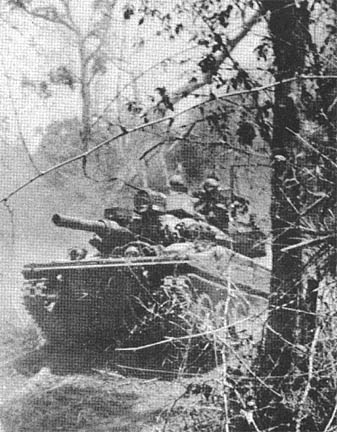 |
Regular’s “Siren” Track Clears Road in Emergency
By SP4 HENRY G. ZUKOWSKI
FSB DEVINS - Remember when you were a kid and used to like to play fireman
and make a lot of noise with bells and clangers just like on a real fire engine?
Well, a 25th Division infantryman, Specialist 4 John Hull, of Alton, Ill., is
still playing “Fireman,” - Vietnam style - with the aid of a “little red siren.”
Hull drives an armored personnel carrier for Company A, 2nd Battalion
(Mechanized), 22nd Infantry. In the past, whenever a mission called for high
speed through a village there was the problem of local citizens jamming the way
with their slow-moving vehicles and carts.
Hull eliminated the problem in a rather unique way.
“I hooked up a little red siren on my APC,” Hull said. “It’s electrically
operated and has the same voltage as the track.”
The siren was originally designed as a warning device for incoming attacks.
According to Hull, it really wails - the sound carries a long way ahead, just
like on a fire truck. Besides, as one of Hull’s fellow soldiers pointed out,
“It’s been extremely effective in clearing the roads.”
| CHAPLAIN (Captain) Joseph Dulany from Tahlequah, Okla., visits the 25th Division’s Charlie Company, 2d Battalion, 14th Infantry “Golden Dragons” near the Cambodian border. (Photo by SP4 Greg Stanmar) |
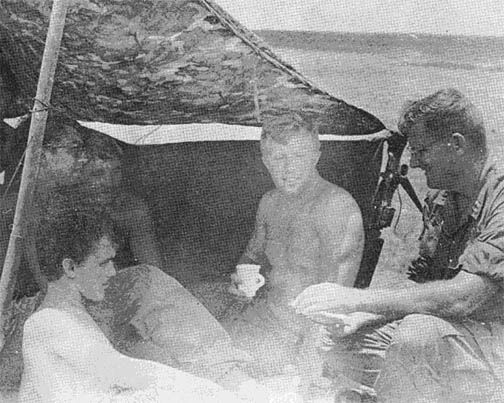 |
Chaplain Enjoys Job
Covers AO with Zeal
By SP4 GREG STANMAR
CU CHI - If chaplains were paid by the mile instead of the month, the 25th
Division’s 2nd Battalion, 14th Infantry chaplain would be a rich man.
“I like to get to every man in this battalion at least once a week,” said
Chaplain (Captain) Joseph P. Dulany, of Tahlequah, Okla. “This means I run from
one end of the AO (area of operations) to the other several times a week.”
In addition, Dulaney, as do the other ten chaplains in the division, has
assignments and responsibilities outside his battalion.
“It keeps you winded,” said the chaplain, “but if you like the job, you don’t
mind. And I like the job. I’ve ‘done time’ in a civilian pastorship and know
what it’s like. At that time I was in the reserves. When it came to a choice
of giving that up or going active I decided to give the Army a try. And so I’m
still here.”
His normal schedule takes the busy chaplain to troops both in the rear and
forward areas. Services last a half hour and are non-denominational.
But often, troops in the field are too spread out to warrant a formal
meeting. Also, it is dangerous to have a large group of people in one area for
any length of time.
In that case, Chaplain Dulany goes to each position handing out leaflets and
talking to the men.
Page 4-5 TROPIC LIGHTNING NEWS May 25, 1970
 |
| NEW LIFE -- These refugees were picked up at an ambush site by the 25th Division’s Charlie Company, 2nd Battalion, 14th Infantry “Golden Dragons,” and brought to a rear area for questioning and processing. |
Thousands Flee Cambodia
Brigade Gives Refugees Help
GO DAU HA -- As a result of increased activity along the Vietnam-Cambodian
border, thousands of refugees and ralliers are coming to the protection of the
25th Infantry Division’s Third Brigade.
The huge exodus from enemy-held land created unparalleled demands for the
civic action and intelligence sections in the brigade.
“I don’t know how many people I’ve processed myself,” said a 25th Division
NCO. “Hundreds, I guess. They (the ralliers) all had the same story. Allied
surprise assaults created chaos in their units allowing them to escape.”
The refugees made up the majority of Vietnamese coming into the American
foward hard spots. Though most came with only a bundle of clothing and a
chicken or two, they were quickly settled into nearby villages and furnished
with a place to live and the possibility of beginning a new life. Others were
taken into the Saigon area until a place could be found for them to live.
“All these people really took us by surprise,” stated Captain Michael J.
Collier of Milwaukee, Wis. “But we’re working overtime to make sure they will
never regret their decision.”
|
Story and Photos By |
 |
IT MAY NOT BE COLD, but it’s wet and it’s welcome. Ralliers are well treated by 25th Infantry Division troops of the 2nd Battalion, 14th Infantry, while they wait to be questioned and processed. |
| NO PAIN - A “Golden Dragon” medic applies a little first aid to a little refugee child. Food, medicine and lodging had to be found for the thousands fleeing from Cambodia as the war intensified in the border area. |
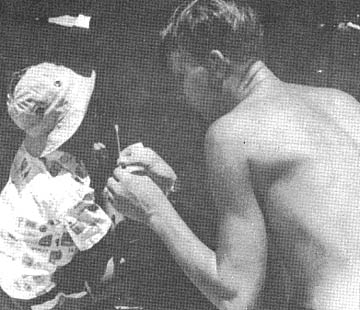 |
 |
EACH refugee coming across the border is questioned by a member of the 2nd Battalion, 14th Infantry “Golden Dragons” assisted by an ARVN interpreter. |
| WAITING FOR A NEW LIFE -- These Cambodian refugees talk about what’s coming up in the future and what they left behind. They are but a few of the hundreds of refugees who have been questioned and detained by the 25th Division’s 3rd Brigade. |
 |
 |
THE END OF the escape from a Communist unit is here for these two Hoi Chanhs as they are met by members of the 25th Division’s 2nd Battalion, 14th Infantry “Golden Dragon” Civic Actions section. |
| QUESTIONING -- Initial questioning of refugees, brought to a rear area by men of the 25th Division’s 2nd Battalion, 14th Infantry “Golden Dragons,” is facilitated with the aid of an ARVN interpreter. |
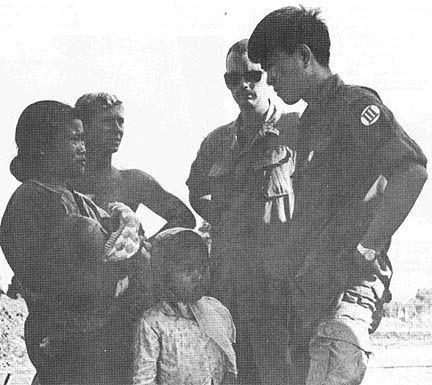 |
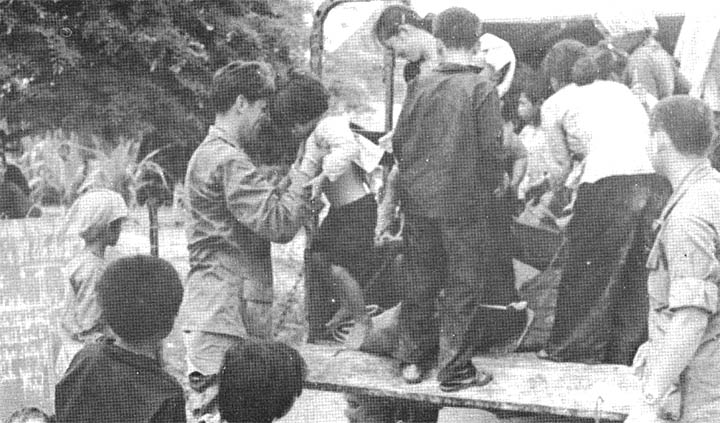 |
| OFF WE GO -- Members of the “Golden Dragons” help refugees off the truck and into a new life. The 2nd Battalion, 14th Infantry was one unit of the 25th Division’s 3rd Brigade that received thousands of ralliers and refugees fleeing from action in Cambodia. |
Page 6 TROPIC LIGHTNING NEWS May 25, 1970
Division Units Gather On Edge of Cambodia
By SGT DAN DELANEY
THIEN NGON - The first day of the 25th Infantry Division’s movement to Thien
Ngon was a “Vietnam” day - hot.
There was very little breeze and the breeze that existed was caused by
airplane propellers. When the engines idled, the breeze was just right.
Two planes took off; one revved his engines getting ready for the short dash
to takeoff and two more circled to land.
When the plane took off there was a lot of wind and dust. Everyone ducked
their heads and pulled their hats on tight, covering their eyes until the gusts
from the airborne aircraft subsided.
Then came the 1st Battalion (Mechanized), 5th Infantry, after 50 kilometers
and a day-and-a-half of travel. Some of the men wore beads and headbands. Some
wore medium long hair and round-or-rectangular-lensed sunglasses.
Names like “Friends of Distinction” and “Christ You Know It Ain’t Easy” were
painted with care on the tracks, along with “Tennessee,” “Kentucky,” “Linda,”
and “Sue.”
The men were reddish-brown with dust from the long ride. No one waved a
peace sign, for this was war.
A CBS camera crewman came across the airfield to take some pictures and a
Chinook landed, picking up the last of the 1st Cav’s 5/7th. The camera crew
filmed the Chinook and the men loading on with their gear.
A 65th Engineer Battalion truck rumbled along the road, towing a generator
and carrying what would be needed for new bridges -- bridges across which an
entire brigade could attack.
The next day, Tropic Lightning quit waiting for the enemy.
 |
YE OLDE SWIMMING HOLE -- It may not be the YMCA, but to these members of the Charlie Company, 2nd Battalion, 14th Infantry “Golden Dragons,” working near the Cambodian border, a bath is where you find it. And, of course, a little horseplay is always in order. (Photo by SP4 GREG STANMAR) |
Munitions Assembler Sees Product in Use
By SP4 FRANK H. SALERNO
CU CHI - After five months in the Army, Specialist 4 Rom Keith of Bravo
Company, 2nd Battalion (Mechanized), 22nd Infantry, began to see how munitions
he had made as a civilian were used in a combat situation.
For two years before he entered the service, Keith helped make 105 and 155mm
artillery rounds, bangalore torpedoes, flammable cylinders, hand grenades, and
small arms ammo at the Sierra Army Depot in Herlong, Calif., his hometown.
One of his first assignments after he arrived in-country was to provide
perimeter security at Fire Support Base Hampton where several 155mm tubes are
located.
“It was hard to believe how fast the artillerymen could fire those guns
compared to the time it took us to assemble a single round at the plant,” Keith
said.
Several weeks later, while at a night laager site, his platoon was working in
a very thickly vegetated area and a bomber dropped a flammable cylinder used to
burn the brush.
“I couldn’t believe it - within minutes the brush area was completely burned
away,” he said.
Another day, his platoon was securing a road which the engineers were
building and one of his company’s jobs was to get rid of the hedgerows bordering
the road. This was to discourage the enemy from ambushing convoys.
The platoon used bangalores, along with time fuses to clear the hedgerows.
“All I can remember is my ears ringing and the smell of powder. It was great
to travel down the road and be able to see through what once was thick brush,”
Keith added.
“I knew that someday I was going to be in the Army and so I put a lot into my
job and encouraged my co-workers to do likewise for the benefit of our guys in
Vietnam,” Keith recalled. “It means the difference between life and death for
us everyday.”
| Ilikai East by Night WED Floor Show on Stage (8 p.m.) THU Night in Las Vegas (8 p.m.) FRI Officers’ Coffee Call (10 a.m.) SAT Films & Popcorn (7:30 p.m.) SUN Gemini Bingo and Birthday Party (8 p.m.) MON Plug-a-Prize (8 pm.) TUE Photo contest entries Whirlpool Table Tennis (8 p.m.) |
Ask Sgt. Certain
DEAR SGT CERTAIN: My problem is my buddy Joe. What am I going to do? We’re
in an artillery unit and he seems to have fallen in love with his Howitzer. He
has named her Hazel. And after cleaning he puts a pink bow around her middle.
He likes to rub her gently and at night he sleeps with his head up against her
base. As far as I know, to this point the Howitzer has not shown any affection.
Good, Good Pal
DEAR GOOD GOOD: Your buddy is headed only for heartache. Howitzers are
treacherous and mean. There is no chance for a sincere two-sided relationship.
I suggest a clean break. A switch to Commo might help him forget. Radios are
warmer and more communicative.
DEAR SGT CERTAIN: I have been told that hard boiled eggs can be neatly sliced
with the blades of a chopper. Is this true.
Gour Met
DEAR GOUR: Yes, hard boiled eggs can be neatly sliced with the blades of a
chopper, also the fingers and hands holding them.
DEAR SGT CERTAIN: When I go to the steam bath, I always get massaged by the
same girl. She is very nice, so I give her a big tip. Sometimes I bring her
gifts. She calls me “Soc Kha.” She is real pretty. What does “Soc Kha” mean?
No Bic
DEAR NO: “Sucker.”
Page 7 TROPIC LIGHTNING NEWS May 25, 1970
From Soap to Books
Manchus Distribute College Gifts to School
Bearcat - American college students have begun to take part in the so-called
“other war.”
Students at St. Olaf College in Northfield, Minn., in response to a request
by one of their alumni, contributed valuable supplies to the Civic Action
Program of the 25th Division’s 4th Battalion, 9th Infantry.
“Manchu” medic, Specialist 6 James Zika, of St. Paul, Minn., contacted his
alma mater and requested a few minor items for his battalion’s civic action
operations.
The overwhelming response was a great surprise to Zika.
“At first there were only one or two boxes,” he said, “but soon it seemed
like they would never stop!”
In all, the students sent thirty boxes with contents ranging from soap to
books.
The Integrated Medical Civic Action Program, at which the student-donated
supplies were distributed, took place at the Vinh Tanh District High School in
Phuoc Thuey Province.
|
Story and Photos By SP4 Lawrence C. Merritt |
| STUDENT -- A student at Vinh Tanh District School practices his English and tells the rest of the class where the gifts they have just received came from. |
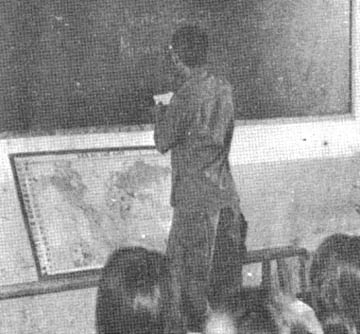 |
 |
BAND AID -- A band aid from a “Manchu” means a lot to the children of Vinh Tanh School District. The children received the first aid during a recent MEDCAP-ICAP conducted by the “Manchus” at the school. |
| CLASSROOM -- Students of Vinh Tanh District School listen attentively as they are told about the gifts they’ve received from the students of St. Olaf College, in Northfield, Minn. |
 |
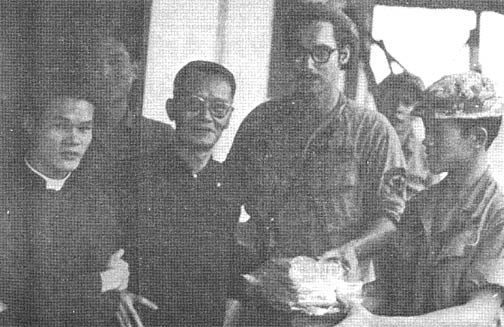 |
FATHER TUI - Father Tui of the Vinh Tanh District School accepts books from Specialist 6 James Zika, of St. Paul, Minn., a medic with the “Manchus.” The books were a gift from the students of St. Olaf College in Northfield, Minn., where Zika was once a student. |
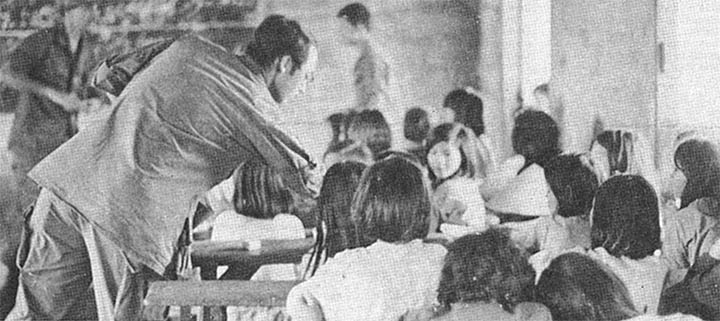 |
| GIFTS -- A “Manchu” medic from the 25th Division’s 4th Battalion, 9th Infantry, leans toward understanding as he passes out gifts to the children of Vinh Tanh District School during a recent MEDCAP-ICAP. |
Page 8 TROPIC LIGHTNING NEWS May 25, 1970
Radar Men Spot Stealthy Enemy
By SP4 ROBB LATO
CU CHI - “Echo One, this is Oscar Papa One Eight - have movement
approximately 400 meters to our front, will stand by, over.”
This could be any one of the members of the 25th Division’s 2nd Battalion,
27th Infantry, radar team reporting their sightings from their secluded radar
post just outside Duc Hoa, 12 miles west of Saigon.
“Our mission is to check an area with radar and a starlight scope,” said
Specialist 4 Mike Ciwakala, of Grand Blanc, Mich. “I guess our job is pretty
important, considering we are the main observation post for all of Duc Hoa and
our battalion forward at Fire Support Base Chamberlain.”
By putting their “Pipsi Five” radar and a large tripod-mounted starlight
scope to work, the crew is able to scan the surrounding area, pinpointing any
enemy that might venture into view.
“As soon as we spot movement and determine its identity and size, we give the
location to our higher command,” said Specialist 4 Walter Meade, of Woodside,
N.Y. “They usually react by sending troops into the area.”
The team operates from a small compound with security elements from one of
the line companies.
“The ARVN help us with our security duties,” said Specialist 4 Tom Gutirres,
of Agana, Guam. “They even helped us build a large bunker for our radar.”
Operating hours for the radar team are between dusk and dawn the next
morning. In the daylight hours the men occupy themselves cleaning their weapons
and equipment, reinforcing their defensive positions or just getting some
well-deserved sleep.
“We have to get clearance and still be very careful when we fire at a target
because of the many hamlets in the area,” said Specialist 4 John Kits, from
Ashville, N.C., a rifleman with the security element.
“Many nights we spot enemy groups and it’s really a temptation to fire on
them,” claimed Sergeant Stephen Ross, a squad leader of the security element,
who is from Naugatuck, Conn. “But it’s really not worth endangering the lives
of the civilians.”
Private First Class Charles Blanchard, the security element’s machine gunner
from Detroit, said, “I never realized how tremendous radar is - it’s great to
see Charlie before he sees you.”
| ALERT -- Specialist 4 Walter Meade of Woodside, N.Y. scans the open terrain with an ARVN soldier, as Private First Class Charles Blanchard of Detroit moves in to adjust the radar for nighttime use. The men operate and secure the radar for 2nd Battalion, 27th Infantry “Wolfhounds.” |
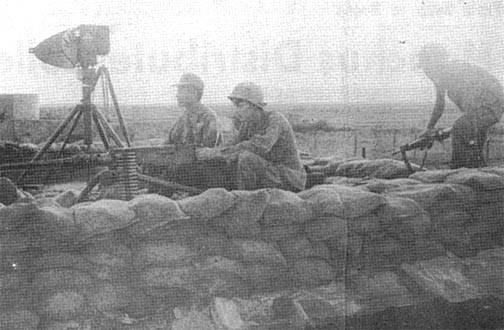 |
DIVARTY E.M. Brief Colonel
By SP4 WILLIAM L. MC GOWN
CU CHI -- Enlisted men do not usually brief visiting dignitaries. But two
25th Infantry Division specialists had that opportunity recently when Colonel
Pham Van Phan, Commander of the 25th ARVN Division Artillery, and his staff
toured the 25th Division Artillery units at Cu Chi.
During the morning session, Phan and his staff were given a briefing on the
organization and operation of DIVARTY Headquarters by Colonel H. A. Buzzett, of
Apalachicola, Fla., and a tour of DIVARTY’S Fire Direction/Target Information
Center. After lunch, Buzzett escorted Phan and his assistants to subordinate
headquarters.
Following a report on the unit’s mission, the ARVN colonel visited the Air
Warning Control Center (AWCC). Here, Specialist 4 Lee G. Parnegos, of Whittier,
Calif., and Specialist 4 Larry Davenport, from Storm Lake, Iowa, briefed Colonel
Phan on the operations of the air control center.
“The colonel seemed very interested in our system of operations here,” said
Parnegos. “After the briefing he came over and asked me some specific questions
about how much data and cooperation we are getting from the ARVN units.”
“Our reason for being here,” said Davenport, “is to act as a clearing agent
for all aircraft in our Area of Operations (AO). Our AO extends from south of Cu
Chi to north of Tay Ninh and includes both US and ARVN artillery which might be
firing in this area.”
“Any pilot on a mission in our AO,” continued Davenport, “can radio in and
know within minutes which artillery units along his route are firing and the
highest trajectory of the round fired. This prevents him from flying low enough
to be hit by any artillery fire from allied units.”
Parnegos also explained that there are different ways of routing aircraft
around artillery fire.
“We can use grid squares, geographical areas, names of cities, or roads.
Usually the ARVNs are more easily directed by geographical locations,” said
Parnegos.
“Colonel Phan already seemed to have a very good grasp of the difficulties of
operating such a large-scale project and was particularly concerned with the
accuracy of data given us by the ARVN units,” Parnegos commented.
“We have been getting more and more data from the ARVNs lately, and it is
getting more and more accurate. This answer seemed to satisfy him.”
Fast and Effective
Aerial Resupply Crucial in Jungle
By SP4 HENRY G. ZUKOWSKI
CU CHI - Aerial resupply has been crucial to the fighting man of the 25th
Division since he arrived in Vietnam five years ago.
The task of resupplying grunts in hard-to-reach places is the responsibility
of men like those in Delta Company, 2nd Battalion (Mechanized), 22nd Infantry.
Thick jungle vegetation, however, has placed severe limitations on the use of
ground transportation in the resupply mission. Consequently, with the
assistance of Chinooks from Cu Chi base camp, the majority of supplies are flown
to men in the field.
Food, water, ammunition, clothing, and - probably most important to the man
in the field - mail is carried by nets attached to the undersides of Chinooks,
thus saving valuable time and space. Personnel are transported inside the
chopper. The entire operation is fast and dependable.
Staff Sergeant Gilbert Paris, of Owensboro, Ky., the man in charge of the
Triple Deuce resupply mission, explained that because of the thick jungle in Hau
Nghia Province, it would be impossible to resupply the men by convoy.
“Roads which are available for transporting supplies simply cannot be swept
for enemy mines and booby traps every day, he said.
Specialist 5 Jerry Dyers, of Troy, Miss., who prepares all equipment before
pick-up added, “We can air-lift more supplies by Chinook faster and with more
effectiveness than we ever could transport with tracks.”
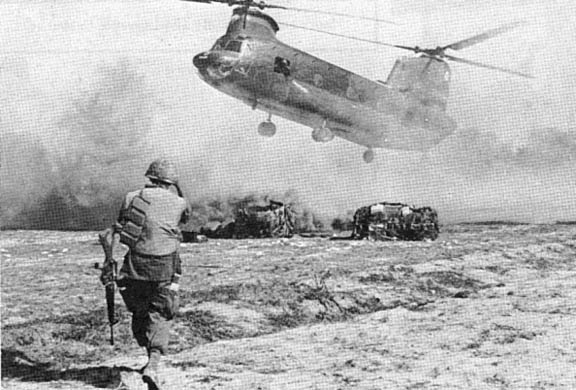 |
| DASH - A trooper from the 2nd Battalion (Mechanized), 22nd Infantry dashes for a Chinook resupply chopper which is on its way to his company’s night laager position near Cu Chi. |
ARVN Arty Soldiers Display Survey Skill
CU CHI -- Two 25th ARVN Division soldiers were recently awarded certificates
of achievement for successfully completing the 25th Division’s 80-hour Field
Artillery Survey Course.
The two ARVNs, First Lieutenant Hoang Xuan Hai, an artillery reconnaissance
officer, and Sergeant First Class Dao Ngoc Nam, an artillery survey sergeant,
enrolled in the course as part of the Dong Tien (“Progress Together”) program of
mutual assistance between the 25th ARVN Division and Division Artillery, 25th
Infantry Division.
One of their instructors, Sergeant First Class Perry J. Rimmer, of Brandy,
Va., commented, “Lt. Hai and SFC Nam were extremely alert throughout the course
and caught on quickly. When they came to us, their background was limited to
aiming circle survey. Through the practical knowledge and experience learned in
the course, they are now skilled in using our more advanced and complicated
survey equipment, including the T-2 theodolite and DME (Distance Measuring
Equipment).”
“In fact,” Rimmer said, “they are now qualified to go back to their unit and
instruct other ARVNs in how to use more modern survey equipment.”
Lt. Hai and SFC Nam are presently stationed in Tan An where they will use
their newly acquired skills to improve and upgrade the professional
qualifications of the ARVN Artillery, thus making their fire support more
accurate and effective.
Thanks to:
Roger Welt, 4th Bn., 23rd Inf., and a Tropic Lightning News correspondent,
for sharing this issue,
Kirk Ramsey, 2nd Bn., 14th Inf. for creating this page.
This page last modified 05-12-2006
©2006 25th Infantry Division Association. All rights reserved